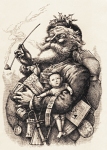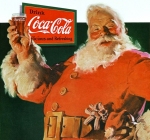 Christmas Traditions »
Christmas Traditions »
The History of Santa Claus
The origin of Santa Claus, one of the most beloved figures of childhood, begins in the 4th century with Saint Nicholas. A Greek Christian, Nicholas was Bishop of Myra, an area in present day Turkey. He was renowned for his good deeds and devotion to children, and was also believed to have used his wealth to secretly give gifts to those in need.
Upon his death on December 6th in 346 A.D., St. Nicholas was buried in Myra and shortly afterward he was elevated to sainthood. In 1087 his remains were removed by Italian sailors and spirited to Bari, Italy where they were placed in a basilica. St. Nicholas' reputation for kindness and philanthropy, as well as claims of miracles he had performed, served to increase devotion to him and his popularity spread throughout Europe. St. Nicholas is the patron saint of many countries, including Russia, where he is known by his red cape, flowing white beard, and bishop's mitre. In Greece, he is the patron saint of sailors and in Belgium the patron of children and travelers. As the patron saint of seafarers in Greece, Sicily and Russia, thousands of churches across Europe were built and dedicated to him, and some time around the 12th century an official church holiday was created in his honor. The Feast of St. Nicholas was celebrated December 6 and the day was marked by gift-giving and charity.
After the movement to reform the Catholic church in the 16th and 17th centuries, European followers of St. Nicholas dwindled, but his legend was kept alive in Holland where the Dutch spelling of his name 'Sint Nikolaas' was eventually transformed to 'Sinterklaas'. In Dutch lore, Sinterklaas arrives on a ship from Spain with his assistant 'Zwarte Piet' ~ meaning Black Pete ~ and Sinterklaas then travels riding a noble white horse, while Black Pete rides a mule. Dutch children would leave their wooden shoes, or clogs, by the fireplace filled with carrots and hay for the horse and mule, and Sinterklaas rewarded those who were good by placing small treats in their shoes. In the 17th century, Dutch colonists brought the tradition of Sinterklaas with them to America and here the Anglican name of 'Santa Claus' emerged.
Present day New York City, once called New Amsterdam, was a Dutch trading post during the 17th century and thus had a large Dutch influence during that period and in ensuing years. In 1804, the New York Historical Society was founded in America with St. Nicholas as its patron saint. In 1809, famed American author Washington Irving, a member of the Society, mentioned St. Nicholas in his satirical work A Complete History of New York written under the pseudonym Diedrich Knickerbocker. In his revised version of the book which was published in 1812, Irving describes St. Nicholas: "—the good St. Nicholas came riding over the tops of the trees, in that self-same wagon wherein he brings his yearly presents to children."
Another New Yorker, printer William Gilley, published a poem in 1821 by an unknown author titled A New Year's Present. In this poem, "Santeclaus" is portrayed as the bringer of gifts to good and virtuous children on Christmas Eve, while leaving birchen rods for those who are naughty. Santeclaus soars over chimney tops being driven - for the first time in written accounts - by a reindeer.
On December 23rd in 1823, the poem A Visit From St. Nicholas, appeared in New York's Troy Sentinel. The poem was anonymously submitted, and appeared in various publications for 13 years without listing an author. It was later attributed to Bible professor Clement C. Moore, and Moore himself claimed authorship of the piece in 1844. However, some evidence exists that it may have been the work of another New Yorker, Major Henry Livingston, Jr., an American of Dutch descent. The poem is also known as The Night Before Christmas, and in it Santa Claus is described:
He had a broad face and a little round belly,
That shook when he laughed, like a bowl full of jelly,
He was chubby and plump, a right jolly old elf,
And I laughed when I saw him, in spite of myself;
A wink of his eye and a twist of his head
Soon gave me to know I had nothing to dread.
Despite the authorship controversy, the poem's popularity helped to spread the concept of Santa Claus as a plump, merry, bringer of gifts.
In the 21st century, the poem is still widely published, particularly in book form, and has become a well-known part of Christmas tradition.
That shook when he laughed, like a bowl full of jelly,
He was chubby and plump, a right jolly old elf,
And I laughed when I saw him, in spite of myself;
A wink of his eye and a twist of his head
Soon gave me to know I had nothing to dread.
German-born American illustrator and editorial cartoonist Thomas Nast played a role in developing the visual image of the modern Santa Claus. Pictures of St. Nicholas and Sinterklaas frequently depicted a tall, thin man wearing a long flowing cape or robe. In a series of drawings for Harper's Weekly magazine, Nast drew Santa as jolly and plump, with a white beard and wearing a fur-trimmed coat and pants along with a black belt and boots — with a bit of a gnome-like appearance. Nast's first drawing appeared in 1862 and, over the next 24 years, 76 of his Christmas engravings were published.
The Coca-Cola company also played a part in creating the look of Santa Claus that is so familiar to many of us today. In an effort to increase their winter sales and their appeal to children, Coca-Cola hired commercial artist Haddon Sundblom to create advertisements featuring a happy, smiling Santa either holding, drinking, giving, or receiving Coca Cola. Sundblom turned to the poem A Visit From St. Nicholas for inspiration, and the first Coca-Cola Santa debuted in 1931 in The Saturday Evening Post. From 1931 to 1964, the Michigan-born artist drew popular holiday ads featuring Santa Claus with Coke, which appeared not only in the Post, but in other publications including National Geographic, Ladies Home Journal, The New Yorker, as well as in calendars, billboards, posters and even plush dolls.
Other countries feature different gift-bearers for the Christmas or Advent season: Father Christmas in England ~ Pere Noël, Father Christmas or the Christ Child in France ~ La Befana in Italy ~ The Three Kings in Spain, Puerto Rico, and Mexico ~ and Christkindl or the Christ Child in Switzerland and Austria.
Christkindl, German for 'Christ Child', was promoted by protestant reformer Martin Luther and intended to replace the figure of St. Nicholas. Luther believed that the popularity of St. Nicholas detracted from the true meaning of Christmas, which was the birth of Christ. Christkindl is usually portrayed as an angelic child with wings and golden curls. During the 18th century, the custom of Christkindl came to America with German and Swiss settlers. It was later simplified to Kriss Kringle, and in America is now synonymous with Santa Claus.
Still, the modern image of Santa Claus as a jolly, benevolent, plump man in a red suit is a combination of the creative influences of authors and illustrators such as Irving, Moore, Nast and Sundblom. It is an image that is loved and recognized by children and adults alike around the world.
© Deborah Whipp









